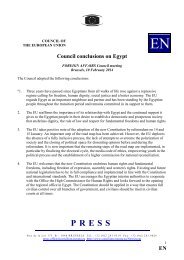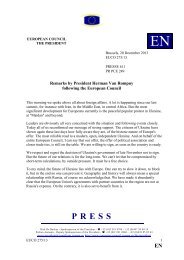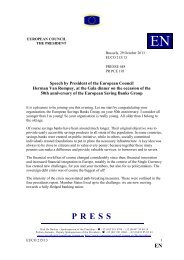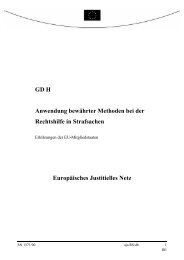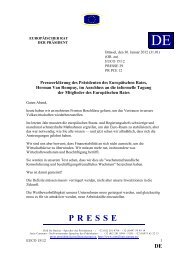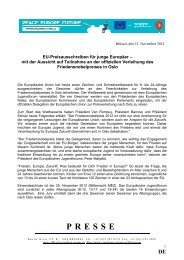14508/09 ADD 1 PL/vk 1 DG G COUNCIL OF THE ... - Europa
14508/09 ADD 1 PL/vk 1 DG G COUNCIL OF THE ... - Europa
14508/09 ADD 1 PL/vk 1 DG G COUNCIL OF THE ... - Europa
Create successful ePaper yourself
Turn your PDF publications into a flip-book with our unique Google optimized e-Paper software.
The most recent information available on sexuality-education contents, teaching methods, etc., can<br />
be found in the Slovenian Presidency's report of 2008. According to that report, sexuality education<br />
within the Members States varies considerably in many parameters. For example, in some countries<br />
children are introduced to the subject as early as five or six, while in other countries that does not<br />
happen before the age of 14. In some countries the topic is presented within traditional school<br />
subjects, while it in some countries it constitutes a school subject in itself. In some countries<br />
sexuality education is standardized by ministries of education and/or health, in some teachers<br />
themselves are responsible for choosing perspectives, selecting topics and methods, and time-<br />
scheduling. Sexuality education also differs thematically. It either includes exclusively biological<br />
and/or physiological facts, on the one hand, and religious beliefs, on the other; or it is complex and<br />
includes issues such as gender equality, self-image and sexual orientation.<br />
Indicator 2 is based on the Health Behaviour in School aged Children (HBSC) 37 databases. The<br />
databases contain information about girls' and boys' satisfaction with their bodies at the ages of 11,<br />
13 and 15. The data from the HBSC study carried out in 2005/2006 shows that in all countries<br />
except Hungary girls' dissatisfaction with their bodies increases over time. In 20 countries 40 % or<br />
more of 15 year old girls think that they are "too fat". This tendency is stronger in countries in the<br />
northern and western parts of Europe. Amongst boys, generally fewer are dissatisfied with their<br />
bodies and the highest degree of dissatisfaction can be found amongst 13 year olds. In all countries<br />
and all age groups girls state that they are "too fat" more often than boys do. The differences<br />
increase with age and the greatest difference between 15 year old girls and boys is 35 percent units<br />
(figure 4.12.1; figure 4.12.2; figure 4.12.3). In all age groups the difference is the greatest in Poland.<br />
In relation to change over time it can be noted that the differences in the HBSC data from the<br />
2001/2002 study and the 2005/2006 study indicate that in 14 MS 15-year-old girls' dissatisfaction<br />
with their bodies decreased, in 9 MS it increased and in 2 it stayed more or less the same<br />
(table 4.12.1). 38 For boys the suggested pattern seems to be somewhat different in this period.<br />
37 http://www.hbsc.org/<br />
38 Comparisons are made in cases where data exists for both times of measurement, i.e. for 25<br />
out of 30 counties. Data exists only for England, Scotland and Wales separately, and for<br />
Belgium (French) and Belgium (Flemish) separately.<br />
<strong>14508</strong>/<strong>09</strong> <strong>ADD</strong> 1 <strong>PL</strong>/<strong>vk</strong> 125<br />
ANNEX <strong>DG</strong> G EN







